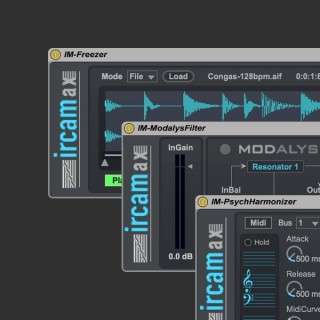 French electronic music center IRCAM (Institut de Recherche et Coordination Acoustique/Musique) has intrroduced IRCAMAX 2, their second collection of Max For Live devices.
French electronic music center IRCAM (Institut de Recherche et Coordination Acoustique/Musique) has intrroduced IRCAMAX 2, their second collection of Max For Live devices.
Audio effects, instruments and a MIDI effect make up this collection of tools for advanced audio processing, sound design and creative experimentation.
Here’s a rundown of the Pack’s instruments and effects.
Effects
- IM-PsychHarmonizer: Vocal harmonizer allowing separation and manipulation of monophonic vocal sounds.
- IM-Freezer: Freezing effect that lets you create sound textures by freezing, scrolling and stretching live or pre-recorded sounds.
- IM-Ianalyzer: A real time polyphonic Audio to MIDI converter that lets you manipulate and resynthesise a signal’s psychoacoustic properties – and capture and reuse the resulting data as MIDI.
- IM-NoteTracker: A Real time Audio to MIDI converter that extracts a signal’s estimated pitch and amplitude and converts them to MIDI note components.
- IM-Chromax: A spectral delay that converts chords into harmonics models, whose set of consisting frequencies can be further transformed, and used to define delay, feedback and filter shapes.
- IM-ModalysFilter: Uses the revered IRCAM Modalys engine to filter the signal with physical modelling processes.
- IM-GrainDelay: A grain delay effect that can be synchronized to Live’s tempo and used with the IRCAMAX MIDI Send/Receive device to receive MIDI notes that control transpositions of the grains.
- IM-MultiFX: Four effects in one – delay, reverb, chorus and auto pan – that can be used as a simple FX box tool for all your synths.
- IM-Midi Send/Receive: Whether coming from a MIDI clip or the result of audio analysis of an audio track, these devices let you send and receive MIDI data between any IRCAMAX device within a Live Set.
Instruments
- IM-ModalysSynth: A polyphonic synthesizer based on IRCAMs flagship Modalys physical modeling engine – technology with over 20 years of research and refinement.
- IM-MatrixSynth: A 3-oscillator, 3-envelope polyphonic synthesizer with a multimode filter and flexible modulation matrix.
Here are the official audio demos:
IRCAMAX 2 is available now for US $199.

I’m fearful the price will keep most at arm’s length. Something about Max for Live devices and $199 that don’t connect. I’m not saying they aren’t worth it, but it’s a big leap from the world of free and sub-$30 dollar land. I wish them all the best, though.
Lux+1 – US$199 is almost Au$250 – is expensive, when I’m only interested in the instruments, not the effects.
Quite interesting seeing a state-funded research organisation like IRCAM trying to turn a profit selling its software!
Guess you’ve never heard of FM synthesis or the Yamaha DX-7?
The FM synthesis patent made Stanford 20+ million dollars.
The moral of the story: these M4L devices are for people that will use them professionally, not hobbyists.
My experience of interviewing Pierre Boulez and visiting the IRCAM several times was that it was a very elitist musical research organisation – so I’m surprised to discover (many years later) that is it stooping so low as to sell software. Interestingly, John Chowning, having been made redundant by Stanford University, took up Boulez’s offer of a position at the IRCAM.
There’s an interesting article here: http://priceonomics.com/the-father-of-the-digital-synthesizer/
“By early 1975, it’s likely that Stanford began to realize it had made a mistake by letting Chowning go. Not only did his patent show promise of making the university “tens of thousands of dollars a month,” but he had been swiftly snatched up by one of the biggest names in music to advise the development of the world’s most advanced digital music center in Paris.”
MIT is the worlds biggest research institute with the microchips and the internet to its name and what happened to those technologies, they moved to California and silicon valley and the rest is history.
contrary to popular belief technology is mainly invented by government money and then sustained in the private sector.
also IRCAM pack 1 was 100$ and worth every penny. will be buying this one too.
State-funded in a neocon world where hospitals should make profit..and of course state funded doesn’t mean the whole world should profit, only the state…
Greatly overpriced, especially since there are only 2 of the included devices I’d be interested in.
Both packs they have created include devices I would like to use, however not all the devices I need or would ever use.
I feel that they bundle many devices together that do not have a central focus. MIDI monitors, Analyzers and then something of interest, to me anyway like, a delay effect/reverb etc…
I think that if they sold them independent, they would sell more and of course we would have an option to get what we needed.
However, its their deal, so whatever, maybe their goal here is different then just commercial success…
Max 4 Live devices have just never seemed solid to me as in they seem to crash a fair bit. Using the M4L selection that comes with ableton suite has resulted in my project getting to a never ending crash loop which I was not able to recover the project with. While I do believe that good coding and such SHOULD come with a price I just can’t justify it when it’s a M4L device. It might very well be my system causing this but I’ve even watched livestreams where Max has crashed on the artist.